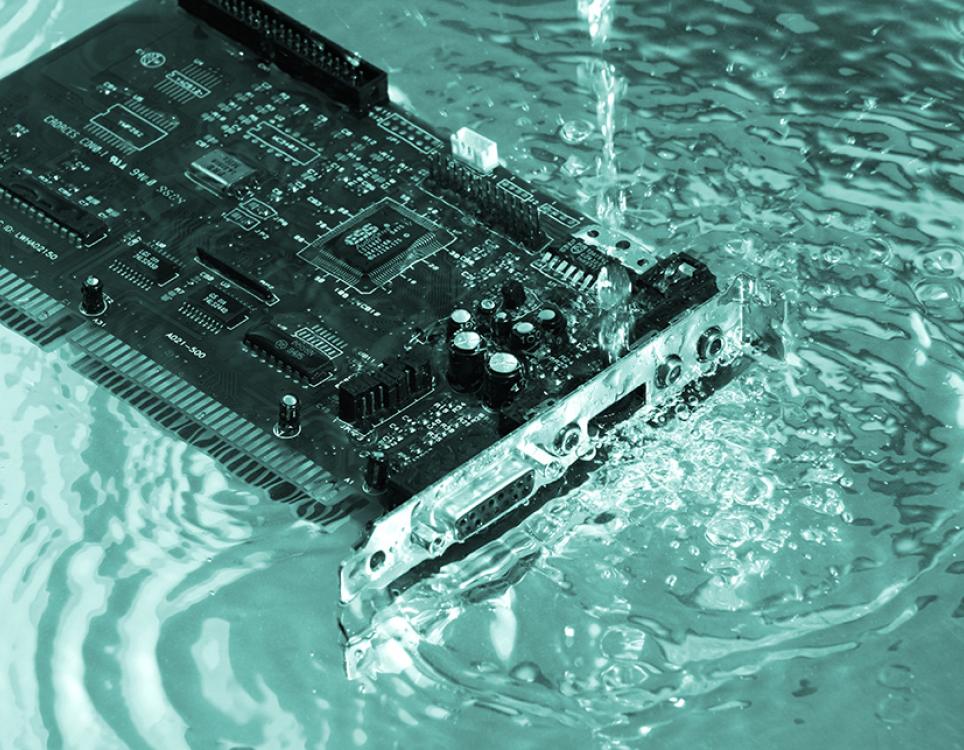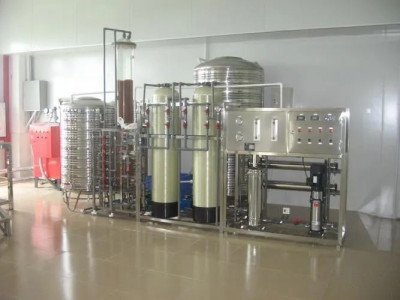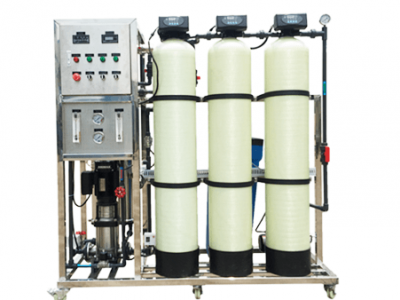Processos comuns de tratamento de água na indústria de semicondutores
Osmose Reversa (RO)
Osmose Reversa (RO) é um processo crucial de tratamento de água amplamente utilizado na indústria de semicondutores. Ele desempenha um papel vital para garantir a produção de produtos semicondutores de alta qualidade e confiáveis.
RO funciona aplicando pressão a uma solução, forçando as moléculas de água através de uma membrana semi-permeável, deixando para trás sólidos e contaminantes dissolvidos. Esse processo remove efetivamente impurezas como sais, minerais, compostos orgânicos e bactérias da água.
A importância do RO na indústria de semicondutores reside em sua capacidade de fornecer água ultra-pura que atenda aos rigorosos requisitos de qualidade dos processos de fabricação de semicondutores. O nível de pureza alcançado pelos sistemas RO está normalmente na faixa de 99% a 99,9%, tornando -o uma etapa essencial para obter alto rendimento e desempenho do produto.
Ao remover as impurezas, o RO ajuda a minimizar os riscos de contaminação durante vários estágios da fabricação de semicondutores. Contaminantes, como partículas, íons e substâncias orgânicas, podem afetar adversamente o desempenho e a confiabilidade dos dispositivos semicondutores. O RO garante que esses contaminantes sejam efetivamente eliminados do suprimento de água, reduzindo a probabilidade de defeitos ou falhas nos produtos finais.
Além disso, a conformidade com os padrões e regulamentos do setor é outro aspecto essencial facilitado pelos sistemas de RO. A indústria de semicondutores possui diretrizes estritas para os níveis de pureza da água para garantir a qualidade consistente do produto em diferentes fabricantes. Ao empregar tecnologia de RO, as empresas de semicondutores podem atender a esses padrões e manter sua reputação de fornecer dispositivos confiáveis e de alto desempenho.
Os sistemas de RO fazem parte de uma configuração de tratamento de água maior que inclui sistemas de pré-tratamento, como filtros de sedimentos, filtros de carbono ativados e filtros multimídia. Essas etapas de pré-tratamento removem partículas maiores e cloro da água de alimentação antes de entrar no sistema RO. Isso ajuda a prolongar a vida útil das membranas RO, impedindo incrustações ou danos causados por sólidos ou produtos químicos suspensos.
Deionização (DI)
A desionização (DI) é um processo crucial de tratamento de água amplamente utilizado na indústria de semicondutores. Esse processo desempenha um papel vital para garantir a qualidade e a confiabilidade da água usada em vários processos de fabricação. Nesta seção, exploraremos o significado da desionização, seu princípio de trabalho e sua aplicação na indústria de semicondutores.
A desionização visa principalmente remover íons dissolvidos da água para alcançar altos níveis de pureza. Envolve passar a água através de resinas de troca de íons especialmente projetadas que atraem e removem partículas carregadas, como cátions (íons carregados positivamente) e ânions (íons carregados negativamente). As contas de resina são normalmente feitas de poliestireno ou outros materiais semelhantes com grupos funcionais que podem se ligar a íons.
O processo de desionização consiste em dois estágios principais: o leito de troca catiônico e o leito de troca ânion. No leito de troca de cátions, íons carregados positivamente, como cálcio, magnésio, sódio e ferro, são trocados por íons de hidrogênio. Da mesma forma, no leito de troca de ânions, íons carregados negativamente como cloreto, sulfato, nitrato e bicarbonato são trocados por íons hidróxido. Como resultado dessas trocas, a água é efetivamente despojada das impurezas mais dissolvidas.
Na indústria de semicondutores, a água desionizada é essencial por vários motivos. Em primeiro lugar, garante a qualidade do produto, eliminando contaminantes que possam afetar negativamente os processos de fabricação de semicondutores. Mesmo quantidades vestigiais de impurezas podem ter efeitos prejudiciais no desempenho e confiabilidade dos componentes eletrônicos.
Em segundo lugar, a água desionizada minimiza os riscos de contaminação durante várias etapas de fabricação. Os dispositivos semicondutores são extremamente sensíveis a partículas minúsculas ou resíduos químicos presentes na água. Ao usar água desionizada durante todo o processo de fabricação, os fabricantes podem reduzir significativamente o risco de defeitos causados pela contaminação por partículas ou interações químicas.
Por fim, a conformidade com os padrões e regulamentos do setor é outro aspecto crítico do uso de água desionizada na produção de semicondutores. O Roteiro Internacional de Tecnologia para Semicondutores (ITRS) estabelece requisitos rigorosos de pureza para o processo de água usada na fabricação de semicondutores. A desionização é um dos principais processos que permite às empresas atender a esses padrões e garantir qualidade consistente em suas operações.
Para implementar a desionização de maneira eficaz, as instalações de semicondutores utilizam sistemas de DI, que normalmente consistem em leitos de resina, tanques de regeneração e equipamentos de monitoramento. Esses sistemas são projetados para lidar com altas taxas de fluxo, mantendo os níveis de pureza necessários. O monitoramento e a manutenção regulares dos sistemas DI são essenciais para garantir o desempenho ideal e evitar possíveis problemas.
Ultrafiltração (UF)
Ultrafiltração (UF) é um processo crucial de tratamento de água amplamente utilizado na indústria de semicondutores. Ele desempenha um papel significativo na obtenção dos níveis de alta pureza necessários para vários processos de fabricação. A UF é particularmente eficaz na remoção de sólidos suspensos, partículas coloidais, bactérias e algumas macromoléculas de fontes de água.
Uma das principais vantagens da UF é sua capacidade de operar a pressões relativamente baixas em comparação com outros métodos de filtração. Isso não apenas reduz o consumo de energia, mas também minimiza o risco de danificar componentes delicados dentro do sistema. As membranas de UF têm tamanhos de poros, variando de 0,01 a 0,1 mícrons, permitindo que eles rejeitem seletivamente partículas e microorganismos, permitindo que as moléculas de água passem.
Ao empregar a UF como parte do processo de tratamento de água, os fabricantes de semicondutores podem garantir que seus produtos atendam aos padrões rigorosos de qualidade e confiabilidade. A remoção de sólidos e contaminantes suspensos ajuda a prevenir a incrustação e a corrosão do equipamento, o que pode comprometer o desempenho e a vida útil do produto.
Além disso, a UF ajuda a minimizar os riscos de contaminação, removendo efetivamente as partículas que podem interferir na produção de wafer ou causar defeitos na superfície dos dispositivos semicondutores. Isso é particularmente crucial em ambientes ultra limpos, onde as impurezas minuciosas podem ter um impacto significativo no rendimento e na qualidade do produto.
Além de atender aos requisitos do produto, a indústria de semicondutores deve cumprir os padrões e regulamentos rígidos do setor em relação à qualidade da água. A UF serve como uma etapa essencial para alcançar esses padrões, fornecendo um meio eficiente de reduzir os níveis totais de carbono orgânico (TOC) em fontes de água. Ao manter consistentemente baixos níveis de TOC, os fabricantes de semicondutores podem garantir a conformidade com os requisitos regulatórios e evitar possíveis multas ou multas.
A implementação dos sistemas UF requer consideração cuidadosa de fatores como qualidade da água de alimentação, seleção de membranas, design do sistema e parâmetros operacionais. Processos de pré-tratamento, como filtros de sedimentos e filtros de carbono ativados, são frequentemente empregados antes da UF para remover partículas maiores e matéria orgânica que podem superar ou danificar as membranas.
Eletrodeionização (EDI)
Eletrodeionização (EDI) é um processo de tratamento de água amplamente usado na indústria de semicondutores. É uma tecnologia avançada que combina aspectos da troca iônica e da eletrodiálise para produzir água de alta pureza para várias aplicações.
No processo EDI, a água de alimentação passa por uma série de camas de resina de troca iônica e membranas seletivas de íons. Esses componentes trabalham juntos para remover íons dissolvidos da água, resultando em água excepcionalmente pura com baixa condutividade.
Uma das principais vantagens do EDI é sua operação contínua. Diferentemente dos sistemas tradicionais de troca iônica que requerem regeneração periódica, o EDI opera continuamente sem a necessidade de produtos químicos ou tempo de inatividade. Isso o torna uma solução econômica para aplicações de tratamento de água de alto volume na indústria de semicondutores.
Outro benefício do EDI é a capacidade de remover uma ampla gama de contaminantes da água de alimentação. Ele efetivamente remove impurezas iônicas dissolvidas, como sais, minerais e metais pesados, garantindo que a água tratada atenda aos requisitos rigorosos de pureza. Isso é crucial nos processos de fabricação de semicondutores, onde até quantidades de impurezas podem afetar negativamente a qualidade e a confiabilidade do produto.
O EDI também oferece benefícios ambientais em comparação com outros métodos de tratamento de água. Ele elimina a necessidade de agentes de regeneração química, reduzindo o uso de produtos químicos e a geração de resíduos. Além disso, requer intervenção mínima do operador e possui uma pequena pegada, tornando-a uma opção eficiente e que economiza espaço para instalações de tratamento de água.
Ao implementar um sistema EDI, o design e o dimensionamento do sistema adequados são essenciais para garantir o desempenho ideal. Fatores como qualidade de água de alimentação, taxa de fluxo e nível de pureza desejado devem ser considerados durante a fase de projeto. A manutenção e o monitoramento regulares também são críticos para evitar problemas de incrustação ou escala que podem afetar a eficiência do sistema.




